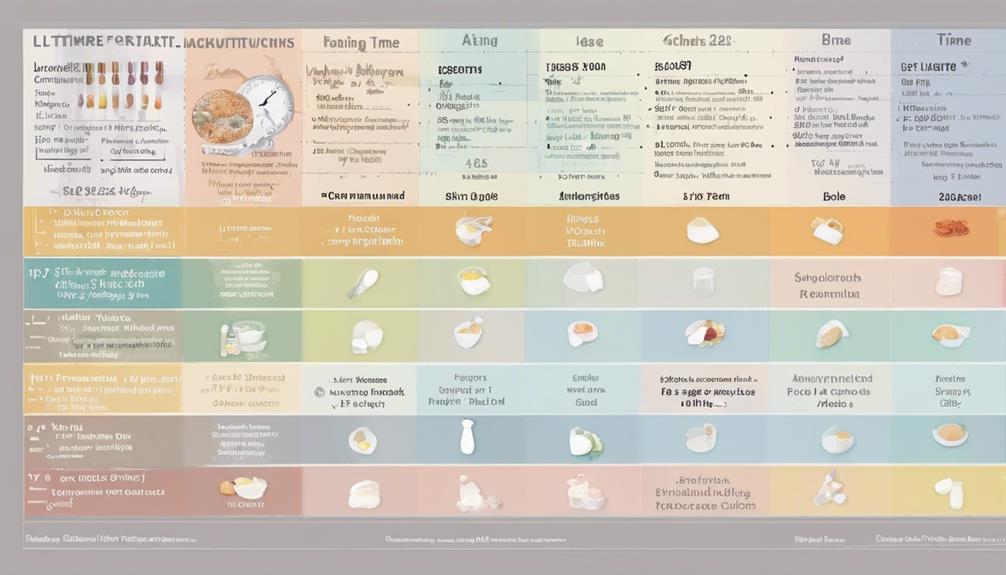Navigating the journey of feeding your 6-month-old can be challenging. You may not be aware of the delicate balance required when introducing solid foods alongside formula.
The shift can be both exciting and challenging, but understanding the nuances of timing, portion sizes, and nutritional requirements is key to a successful feeding routine.
Stay tuned as we explore practical tips and insights that can help you maneuver this critical phase of your baby's development with confidence and ease.
Key Takeaways
- Introduce solids at 6 months for taste exploration and essential nutrients.
- Gradually transition to formula feeds, monitoring acceptance and quantities.
- Maintain a consistent meal schedule with formula feeds and solid meals.
- Monitor reactions, adjust intake based on hunger cues, and consult healthcare providers.
Importance of Introducing Solids
Introducing solids around the age of 6 months is important for infants as it allows them to explore new tastes and textures while providing essential nutrients for their growth and development.
Solids play a critical role in providing key nutrients such as iron and zinc, which are essential for a baby's overall health.
Additionally, the introduction of solid foods supports the development of oral motor skills, helping babies learn to chew and swallow effectively.
Transitioning to Formula Feeding

Shifting to formula feeding typically involves gradually substituting one breastfeeding session with formula each day, ensuring to monitor the baby's acceptance and adjusting as needed with guidance from healthcare professionals. When moving from breastfeeding to formula feeding, it is important to offer formula in a bottle with a slow-flow nipple to mimic the breastfeeding experience. Making sure the formula is warmed to body temperature before feeding can make it more appealing to the baby. Monitoring formula acceptance is vital, adjusting quantities and schedules as needed to facilitate a smooth change. Seeking guidance from a pediatrician or lactation consultant can provide valuable support and guarantee successful formula feeding. Below is a helpful table to guide you through the shift process:
| Tips for Switching to Formula Feeding |
|---|
| Gradually replace one breastfeeding session with formula daily |
| Use a bottle with a slow-flow nipple for formula feeding |
| Seek guidance from healthcare professionals for a successful switch |
Scheduling Solid Food Meals
After establishing a smooth switch to formula feeding, the next step in your baby's feeding journey involves creating a structured schedule for introducing solid food meals. Begin by gradually introducing solid food meals, starting with one meal per day. This approach allows your baby time to adjust and explore new tastes and textures.
Aim for a consistent meal schedule, offering solids around the same time each day to establish a routine that your baby can anticipate. It's important to make sure there's a gap of 1-2 hours between milk feeds and solid meals. This break helps prevent interference with digestion and ensures your baby can fully enjoy their solid food.
As you introduce new foods, monitor your baby's reactions closely. Adjust meal times based on their hunger cues and preferences. Keeping track of the types of solids introduced and any allergic reactions can help identify potential food sensitivities early on.
Remember to always monitor your baby's preferences and adjust the feeding schedule accordingly.
Incorporating Formula in Daily Routine

Incorporating formula into a 6-month-old baby's daily routine involves ensuring they receive essential nutrients and calories through 4-6 bottle feeds per day, with each feeding session ranging from 4-6 ounces based on the baby's appetite and needs. It's important to follow the manufacturer's instructions for preparing and storing formula to guarantee proper nutrition and safety. By combining formula with solid foods, you can meet your baby's growing nutritional requirements effectively. Consulting with a pediatrician is essential as they can help determine the right formula type and feeding schedule tailored to your baby's individual needs and development.
| Feeding Schedule | Formula Feeding |
|---|---|
| 4-6 bottle feeds per day | Providing essential nutrients and calories |
| Each feeding session: 4-6 ounces | Based on the baby's appetite and needs |
Monitoring Baby's Nutritional Needs
To guarantee top growth and development, monitoring a baby's nutritional needs is essential during the first year of life. It's important to pay attention to your baby's feeding needs to make sure they're getting the right amount of nutrients for their individual needs.
Here are some key points to keep in mind:
- Hunger and Fullness Cues: Watch for cues that indicate hunger or fullness to determine how much to feed your baby.
- Solid Meal Intake: Keep track of how much solid food your baby is getting and adjust according to their acceptance.
- Vitamin D: Make sure your baby is receiving adequate vitamin D, either through sunlight exposure or supplements as recommended by your healthcare provider.
- Consultation: Regularly consult with a pediatrician or dietitian to make sure your baby's nutritional requirements are being met.
- Feeding Guide: Use a feeding guide as a reference but remember to tailor it to your baby's needs and preferences.
Frequently Asked Questions
Should I Feed Solids and Formula at the Same Time?
We recommend feeding solids and formula separately to maintain a balanced nutrition intake. Offering them at the same time may lead to interference. Let's stick to the plan of introducing them separately to make sure the baby gets the best of both worlds.
How Often Should I Feed My Baby After Starting Solids?
After starting solids, we gradually increase solid feeds 1-2 times daily, aligning with baby's readiness. We continue regular milk feeds, offering solids separately. Adapting to hunger cues, we adjust frequency to match appetite. Personalized guidance from a pediatrician guarantees ideal nutrition.
Do Babies Need Formula After Starting Solids?
Yes, babies need formula after starting solids. Formula provides essential nutrients like iron and zinc that solid foods may lack. It complements a balanced diet and is recommended by the American Academy of Pediatrics until at least 12 months.
How Much Milk Should a 6 Month Old Drink When Eating Solids?
We aim to provide balanced nutrition for our 6-month-old by ensuring they drink 22-28 oz of breast milk or formula daily when introducing solids. Monitoring milk intake alongside solid food progression helps maintain a healthy diet.
Conclusion
To sum up, introducing solids and formula at 6 months is essential for a balanced diet. By gradually switching and monitoring their nutritional needs, parents can guarantee their baby's healthy growth and development.
For example, Sarah started incorporating purees into her baby's diet, and within weeks, she noticed improved digestion and increased interest in trying new foods.
Remember, every baby is different, so always consult with a healthcare provider for personalized feeding guidance.










